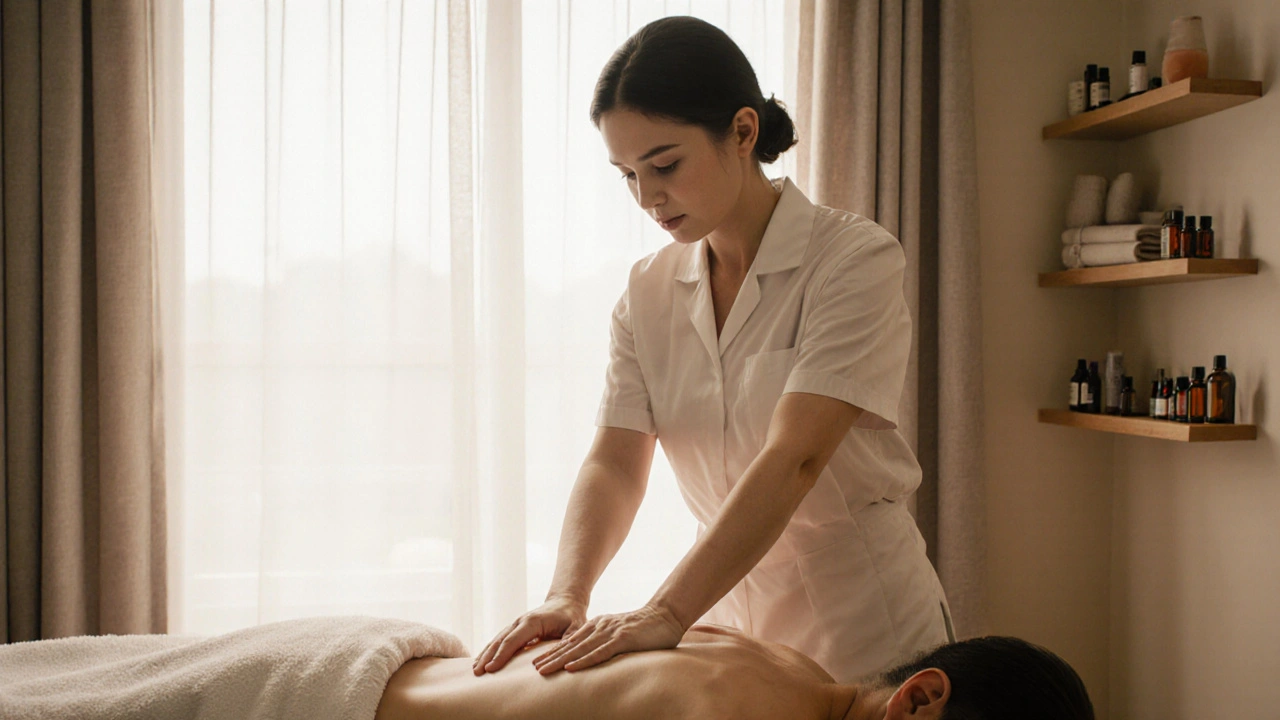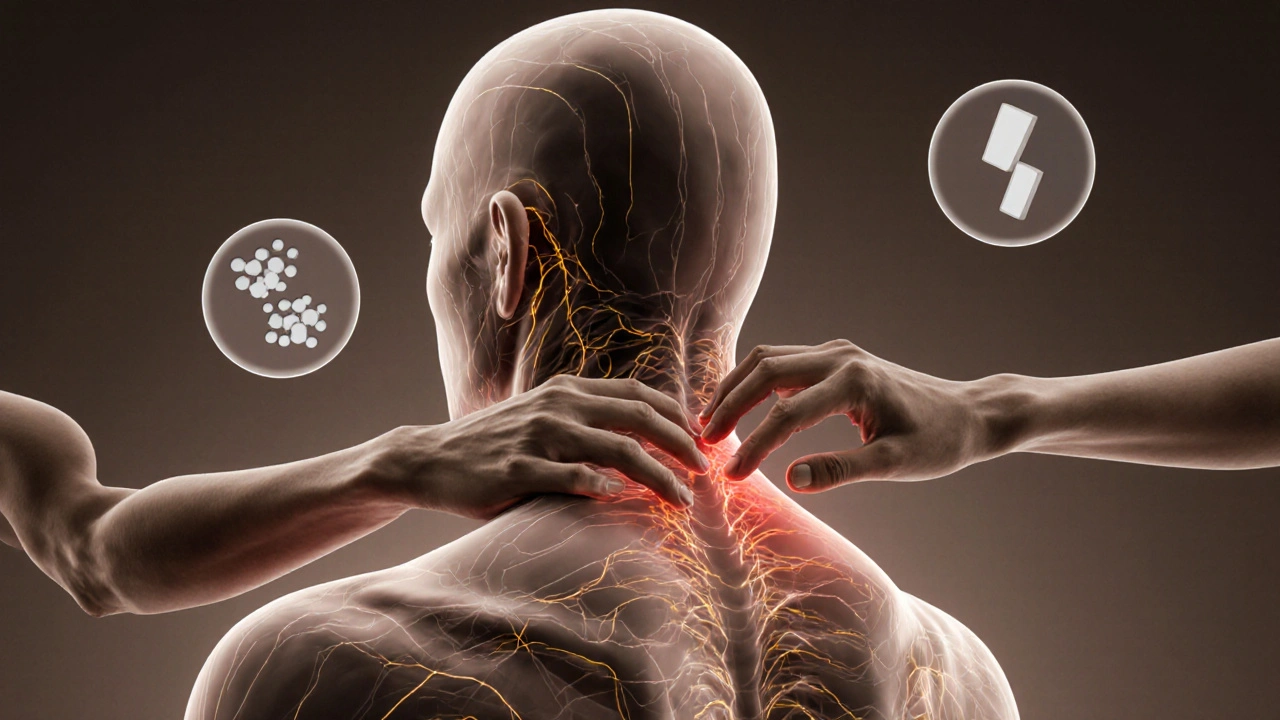Discover what a certified massage therapist can truly do for your body-beyond relaxation. Learn how massage therapy relieves pain, improves mobility, and supports recovery in London's busy lifestyle.

- Created by: Archer Caldwell
- Completed on: 7 Nov 2025
- Categories: Massage Therapy
You’ve probably felt it - that tightness in your shoulders after a long week, the dull ache in your lower back from sitting too long, or the way your mind just won’t shut off even when you’re lying in bed. You’ve tried stretching, meditation, even sleep. But what if the missing piece isn’t more effort - but the right kind of touch?
What a Massage Therapist Actually Does (It’s More Than Just Rubbing)
A massage therapist isn’t just someone who kneads your muscles. They’re trained to read your body like a map. Every knot, every tense band, every restricted joint tells a story. And their job? To listen to that story - and help you rewrite it.
Think of them as movement detectives. They don’t just push on sore spots. They look at how your hips tilt when you walk, how your breath changes when you’re stressed, how your neck pulls to one side when you’re tired. They use techniques like Swedish strokes, deep tissue work, myofascial release, and trigger point therapy - not to hurt, but to unlock.
And here’s the thing most people miss: they’re not just fixing pain. They’re helping your nervous system reset. When your muscles are tight, your body thinks it’s under threat. A skilled therapist gently tells your nervous system, “You’re safe now.” That’s when real relaxation kicks in - not just the kind you get on a couch, but the deep, cellular kind that lowers cortisol, improves sleep, and even boosts immunity.
Why Your Wellness Journey Needs More Than a Gym Membership
Most wellness plans focus on what you do - run more, eat clean, meditate daily. But what about what you receive? Your body doesn’t just need movement. It needs release. It needs to be held. It needs to feel safe again.
Studies show that regular massage therapy reduces stress hormones by up to 31% and increases serotonin and dopamine - the feel-good chemicals - by over 25%. That’s not magic. That’s physiology. And it’s why people who combine exercise with massage therapy report better recovery, fewer injuries, and more consistent motivation.
Take Sarah, a 38-year-old teacher. She ran five days a week, ate organic, and did yoga every morning. But she still woke up with headaches and jaw pain. Turns out, her stress wasn’t just mental - it was locked in her neck and shoulders. After six weeks of weekly sessions with a massage therapist, her headaches dropped from five times a week to once a month. She didn’t change her routine. She just added touch.
The Different Ways a Massage Therapist Can Help You
Not all massage therapists are the same. And neither are their approaches. Here’s what you might actually need:
- Relaxation massage: For when you’re mentally drained. Light pressure, flowing strokes. Think of it as a reset button for your nervous system.
- Deep tissue massage: For chronic pain, old injuries, or stubborn knots. Slower, focused pressure to reach deeper layers of muscle and connective tissue.
- Sports massage: For active people. Focuses on performance, recovery, and preventing strains. Often used before or after workouts.
- Pregnancy massage: Tailored for expectant mothers. Supports posture, reduces swelling, and eases sciatic pain - all while keeping mom and baby safe.
- Myofascial release: Targets the fascia - the web-like tissue that wraps around muscles. When it gets stuck, everything else tightens up.
- Trigger point therapy: Focuses on hyper-irritable spots that cause pain in other areas. Like when your shoulder pain is actually coming from your upper back.
Good therapists don’t push one technique on everyone. They ask questions. They adjust. They listen. That’s what makes the difference between a nice rub and real healing.
What Happens During Your First Session?
It’s not what you think. No one’s going to drag you into a dim room and make you strip naked on a table. That’s a myth.
Here’s what actually happens:
- You’ll fill out a short health form - injuries, medications, allergies, pregnancy status. This isn’t bureaucracy. It’s safety.
- You’ll chat for 5-10 minutes. They’ll ask where you hurt, what you do all day, how you sleep. Be honest. This isn’t a judgment zone.
- You’ll get covered with a sheet or towel. Only the area being worked on is exposed. You’re never awkwardly exposed.
- They’ll use oil or lotion. It’s not about romance - it’s about reducing friction so their hands glide smoothly.
- They’ll check in. “Is this pressure okay?” “Does this spot feel better?” They’re not guessing. They’re tuning in.
- You’ll leave feeling lighter, calmer, maybe a little sore - but in a good way. Like you’ve been given back your body.
And if they don’t ask questions? Walk away. A good therapist cares about your story, not just your muscles.

How Often Should You See One?
There’s no magic number. But here’s what works for most people:
- For acute pain (like a pulled muscle or new back flare-up): Once a week for 3-4 weeks, then taper off.
- For chronic stress or tension: Every two weeks helps keep your nervous system balanced.
- For maintenance: Once a month keeps your body from slipping back into old patterns.
- For athletes: Weekly or biweekly, depending on training load.
Some people come once a year - just to reset. Others come weekly because they’ve learned how much better life feels when their body isn’t fighting itself.
How to Find a Real Massage Therapist (Not Just a Spa Worker)
Not everyone calling themselves a “massage therapist” has the training. Here’s how to spot the real deal:
- Check their license. In most places, licensed massage therapists (LMTs) have completed 500-1,000 hours of training and passed a national exam.
- Look for credentials like NCBTMB (National Certification Board for Therapeutic Massage & Bodywork) or state licensing.
- Read reviews that mention specific results: “My migraines stopped,” “I could finally sleep on my side,” not just “They were nice.”
- Ask if they do assessments. A good therapist doesn’t just start massaging. They ask about your posture, movement, lifestyle.
- Trust your gut. If they rush you, ignore your pain, or push you into a package deal, they’re selling a service - not healing.
Don’t go to the cheapest option. Go to the one who listens.
Massage Therapist vs. Spa Massage: What’s the Difference?
| Feature | Massage Therapist | Spa Massage |
|---|---|---|
| Training | 500-1,000+ hours, licensed, anatomy-focused | Often 100-200 hours, minimal certification |
| Goal | Healing, pain relief, functional improvement | Relaxation, pampering, short-term stress relief |
| Assessment | Health history, posture, movement checks | Usually none - “just relax” |
| Customization | Techniques adjusted for your body and goals | Standardized 60- or 90-minute packages |
| Follow-up | May suggest stretches, lifestyle changes, or follow-ups | Rarely |
If you’re dealing with chronic pain, posture issues, or stress that won’t quit - you need a therapist. If you just want to smell lavender and sip tea? A spa is fine.

What to Do After Your Session
Don’t rush off. Your body is still processing.
- Drink water. Massage releases toxins and metabolic waste. Hydration helps flush them out.
- Take it easy. Avoid intense workouts or heavy lifting for 24 hours. Let your body integrate the changes.
- Notice how you move. Do you breathe deeper? Stand taller? Walk differently? That’s the work sticking.
- Keep a journal. Write down how you felt before and after. Over time, you’ll see patterns - and know when to come back.
Some people feel sleepy. Others feel energized. Both are normal. It’s not about how you feel right after - it’s about how you feel three days later.
Frequently Asked Questions
Do I need to be naked during a massage?
No. You’ll be covered with a sheet or towel at all times. Only the area being worked on is exposed, and you can keep your underwear on if you’re more comfortable. A professional therapist respects your boundaries - always.
Can massage therapy help with anxiety?
Yes. Studies show regular massage lowers cortisol (the stress hormone) and increases serotonin and dopamine. It doesn’t replace therapy or medication, but it’s a powerful tool to calm the nervous system and create space for emotional healing.
Is massage therapy covered by insurance?
Sometimes. If you have a doctor’s referral for chronic pain, injury recovery, or a diagnosed condition like fibromyalgia, some insurance plans cover it. Check your policy or ask your therapist if they accept insurance.
Can I get a massage if I have a medical condition?
Most conditions are fine - as long as you tell your therapist. Diabetes, high blood pressure, arthritis, even cancer - trained therapists know how to adapt techniques safely. But never hide your diagnosis. It’s not just about comfort - it’s about safety.
How long does it take to see results?
Some people feel better after one session - especially with stress or tension. For chronic pain or structural issues, it usually takes 3-6 sessions to see lasting change. Think of it like physical therapy: consistency builds results.
Your Body Is Talking - Are You Listening?
Massage therapy isn’t a luxury. It’s a form of self-care that’s as vital as eating well or moving your body. A massage therapist doesn’t fix you. They help you remember how to relax, how to breathe, how to feel safe in your own skin again.
You don’t need to wait until you’re in agony to try it. You don’t need to be an athlete or someone with a chronic condition. You just need to be tired - really tired - of carrying the weight of your life in your shoulders.
Start small. One session. See how you feel. If it helps - come back. If it doesn’t - you’ve lost nothing but a few hours. But if it does? You might just find that the missing piece of your wellness journey has been in your hands all along - waiting for someone to hold them gently.
Looking for the best relaxing massage in London? Discover how to unwind and recharge with top-rated massage experiences, tips, and inside info about what really works.
Ready to take the edge off after a long day? This article breaks down how foot massage can quickly ease stress, boost energy, and help you relax at home or at a spa. You'll discover the real perks, simple tips to find great services, and what to expect during a session. Learn the nuts and bolts, plus some clever tricks for getting the most out of every foot rub. Step into a world where downtime actually counts.




Paige Vejnar
November 8, 2025 AT 12:04I literally cried during my first massage because my therapist asked if I’d been holding my breath for years 😭 I didn’t even realize I was doing it… now I do it every two weeks and my anxiety? Gone. My cat even notices I’m calmer. She sleeps on my chest now. 🐱💕
Vanness Latricia
November 8, 2025 AT 23:24OMG YES. I used to think massage was just a fancy spa treat until I started having chronic migraines after my divorce. Six weeks of deep tissue and myofascial release and suddenly I could sleep through the night without waking up with my jaw clenched so hard I thought I’d crack a tooth 🤯 I didn’t change my diet, I didn’t start therapy (yet), I just let someone touch me the right way. And now? I’m obsessed. I’ve convinced three friends to go. One of them cried too. We’re like a secret society now. 🫶 #MassageTherapyIsSelfCare
Debbie Nehikhuere
November 10, 2025 AT 14:09My therapist told me once: ‘Your body remembers what your mind tries to forget.’ That stuck with me. I used to think healing meant fixing something broken. Turns out, it’s just remembering how to relax. One session at a time. No grand gestures needed. Just presence. And good hands.
Michael Soaries
November 12, 2025 AT 10:35I never thought I’d say this but I started going after my back went out during a yoga class. I was skeptical. Now I go every month. My posture’s better. I sleep deeper. And I don’t reach for ibuprofen anymore. Honestly it’s the only thing that’s helped more than walking. No hype. Just results.
Sean Fimio
November 12, 2025 AT 21:28Wait wait wait… so you’re saying massage therapists aren’t just people who rub your back with lavender oil??? 😳 I thought it was all like… spa vibes and candles and soft music?? I went once and the lady asked me about my sitting posture and if I had sciatica and I was like ‘…what??’ But then she fixed my hip pain in 20 mins and now I’m hooked?? Like… legit?? 😅 I didn’t even know fascia was a thing??
Dr. Atul James Singh
November 13, 2025 AT 12:35Empirical data confirms that somatic intervention modulates autonomic nervous system output via parasympathetic upregulation, reducing cortisol levels by 27-31% as per meta-analyses from the Journal of Clinical Psychology (2021). The efficacy is statistically significant (p<0.01). However, commercialization has led to credential dilution-verify licensure via NCBTMB database before scheduling. Avoid spas. Seek LMTs with biomechanical assessment protocols. Otherwise, you're paying for aromatherapy, not neurophysiological recalibration.
peter may
November 14, 2025 AT 03:33One cannot help but observe the profound philosophical implications embedded within the notion of ‘touch as healing’-a concept that harks back to the ancient Greek notion of ‘iatros’-the healer who restores harmony through physical presence. One might argue, then, that massage therapy is not merely a modality, but an ontological reclamation: the body, once alienated by modernity’s relentless pace, is re-ensouled through the deliberate, compassionate pressure of another’s hands. To deny this is to deny the very essence of human interbeing.